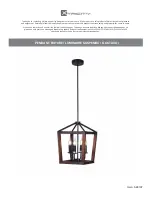
TM0497-2002
NACE International
17
10.3.5.7 Install and place in operation necessary
interrupter equipment in all significant DC sources
protecting the pipe at the test site, and place in
operation with a synchronized and/or known “off”
and “on” cycle. The “off” cycle should be kept as
short as possible but still long enough to read a
polarized pipe-to-electrolyte potential after any
“spike” as shown in Figure 3a has collapsed.
10.3.5.8 Measure
and
record
the
pipe-to-
electrolyte “on” and “off” potentials and their
polarities with respect to the reference electrode.
The difference between the “off” potential and the
corrosion potential is the amount of polarization
formation.
10.3.5.8.1 If spiking may be present, use an
appropriate
instrument,
such
as
an
oscilloscope or high-speed recording device,
to verify that the measured values are not
influenced by a voltage spike.
10.3.6 Evaluation of Data
Cathodic protection shall be judged adequate if
100 mV or more of polarization formation is
measured with respect to a standard reference
electrode.
10.3.7 Monitoring
When at least 100 mV or more of polarization
formation has been measured, the pipeline “on”
potential may be used for monitoring unless
significant
environmental,
structural,
coating
integrity, or cathodic protection system parameters
have changed.
________________________________________________________________________
References
1.
NACE Standard RP0169 (latest revision), “Control of
External Corrosion on Underground or Submerged Metallic
Piping Systems” (Houston, TX: NACE).
2.
NACE Standard RP0177 (latest revision), “Mitigation of
Alternating Current and Lightning Effects on Metallic
Structures and Corrosion Control Systems” (Houston, TX:
NACE).
3.
F.J. Ansuini, J.R. Dimond, “Factors Affecting the
Accuracy of Reference Electrodes,” MP 33, 11 (1994), p.
14.
4.
NACE Publication 35201 (latest revision), “Technical
Report on the Application and Interpretation of Data from
External Coupons Used in the Evaluation of Cathodically
Protected Metallic Structures” (Houston, TX: NACE).
________________________________________________________________________
Bibliography
Ansuini, F.L., and J.R. Dimond.
“Factors Affecting the
Accuracy of Reference Electrodes.” MP 33, 11 (1994):
pp. 14-17.
Applegate, L.M.
Cathodic Protection.
New York, NY:
McGraw-Hill, 1960.
Bushman, J.B., and F.E. Rizzo.
“IR Drop in Cathodic
Protection Measurements.” MP 17, 7 (1978): pp. 9-13.
Cathodic Protection Criteria — A Literature Survey.
Ed.
coord. R.A. Gummow. Houston, TX: NACE, 1989.
Corrosion Control/System Protection, Book TS-1, Gas
Engineering and Operating Practices Series. Arlington,
VA: American Gas Association, 1986.
Dabkowski, J., and T. Hamilton. “A Review of Instant-Off
Polarized
Potential
Measurement
Errors.”
CORROSION/93, paper no. 561. Houston, TX: NACE,
1993.
Dearing, B.M. “The 100-mV Polarization Criterion.” MP 33,
9 (1994): pp. 23-27.
DeBethune, A.J.
“Fundamental Concepts of Electrode
Potentials.” Corrosion 9, 10 (1953): pp. 336-344.
Escalante, E., ed. Underground Corrosion, ASTM STP 741.
Philadelphia, PA: ASTM, 1981.
Ewing, S.P.
“Potential Measurements for Determining
Cathodic Protection Requirements.”
Corrosion 7, 12
(1951): pp. 410-418.
Gummow, R.A. “Cathodic Protection Potential Criterion for
Underground Steel Structures.” MP 32, 11 (1993): pp.
21-30.
Jones, D.A.
“Analysis of Cathodic Protection Criteria.”
Corrosion 28, 11 (1972): pp. 421-423.
NACE Publication 2C154.
“Some Observations on
Cathodic Protection Potential Criteria in Localized
Pitting.” Houston, TX: NACE, 1954.
NACE Publication 2C157.
“Some Observations on
Cathodic Protection Criteria.”
Houston, TX:
NACE,
1957.
Содержание CP 1
Страница 1: ...CP 1 Cathodic Protection Tester Course Manual February 2005 NACE International 2000 ...
Страница 265: ......
Страница 266: ......
Страница 267: ......
Страница 268: ......
Страница 301: ...RP0169 2002 32 NACE International ISBN 1 57590 035 1 ...
Страница 535: ...TM0101 2001 24 NACE International ISBN 1 57590 137 4 ...
















































